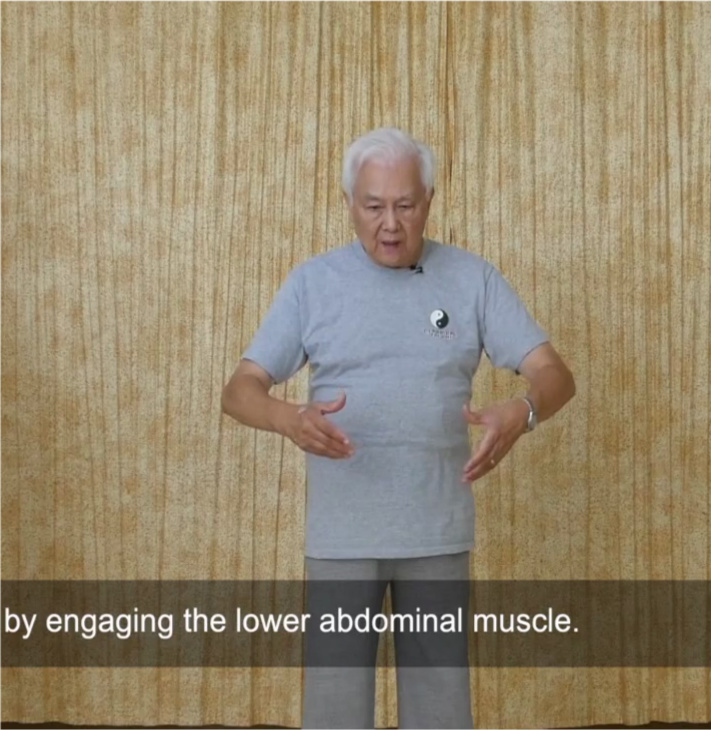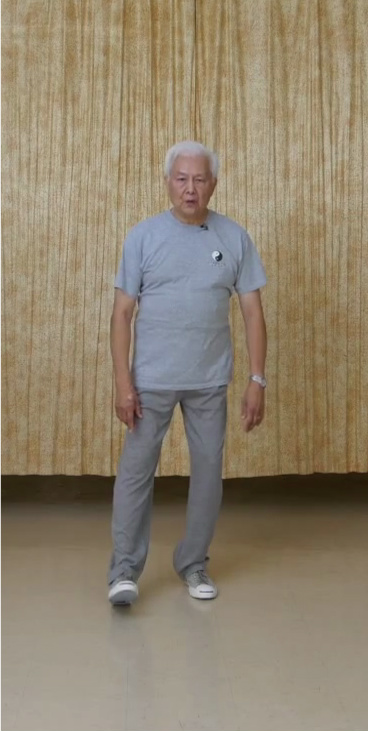This movement teaches the student or patient how to bring the body forward and backward. These pictures are a segment from a sequence of movements called "Tai Chi Walk." The starting posture, see Picture 1-1, is with the feet parallel at shoulder-width. Now the derriere (buttocks) need to be "tucked in" (euphemistically). It is not a frozen "pelvic tilt"; one needs to stretch the tailbone downward by engaging the lower abdominal muscle.
Stretch the head using the neck muscle; you want to feel a stretch and tuck in the chin very slightly. Now bend the knee and take a step forward onto the heel of either the right or left foot; see Picture 1-2. Note in Pictures 1-2 that the hips face ahead with the body facing exactly forward. In pictures 1-3, the toe goes down, but the body weight stays on the back foot; this is very important that no body weight "leaks" into the front foot from just putting down the toe. In pictures 1-4, you will pull the body forward using the front foot; note that you do not push with the back foot.
Using the exact timing as you bend the knee, you "energize" the core (abdominal) muscles and pull the body forward. This "energizing" of the core is a euphemism for a somewhat sharp contraction, a pulling inward of the abdominal muscles below the navel. Pulling the body backward uses the same technique, see Picture 1-5 by pulling with the back foot while you "energize" (sharply contract) the core. One will repeat the pulling back and pulling forward using the core muscles in conjunction with the pull, over and over, forward, back, forward, back, etc. In the forward position, it looks like one is tilting slightly forward; in the backward position, it looks like one is about to sit in a chair. The contraction inward of the core stimulates all the internal organs, the blood flow, and lymphatic flow, becoming a very healthful movement for the internal organs. Another great benefit is stretching the spine by tilting forward and sitting back. When one learns to use the core to energize the movement, it takes much of the workload from the legs, thus relaxing them in the process.
One can Push Hands or do the Classical Tai Chi Form. In either case, one is transitioning between moving forward or sitting back. At a seminar, I heard a student ask: "Is the tuck a pelvic tilt"? The tuck is what is called a pelvic tilt. A while back, Master Hwa started using the term "stretch the back down" to describe what he had called "tuck." Tuck the derriere does require the press in or contraction of the lower abdomen. As a student improves, however, a student can discover that the neural signal to "stretch the back down" will result in an abdominal contraction.
We have established that the nervous system in Classical Tai Chi learns by discerning the difference between even the smallest of sensations. Therefore, students develop the ability to tell the difference between one sensation and another, first on a macro level, e.g., the difference between the pelvic tilt and stretching down the back, then later, more subtle differentiation. However, a downside can also be an extreme disadvantage with a pelvic tilt. It freezes the ability to turn the waist by making that area static, whereas stretching down the back keeps the ability to turn fluid and dynamic.












No comments:
Post a Comment